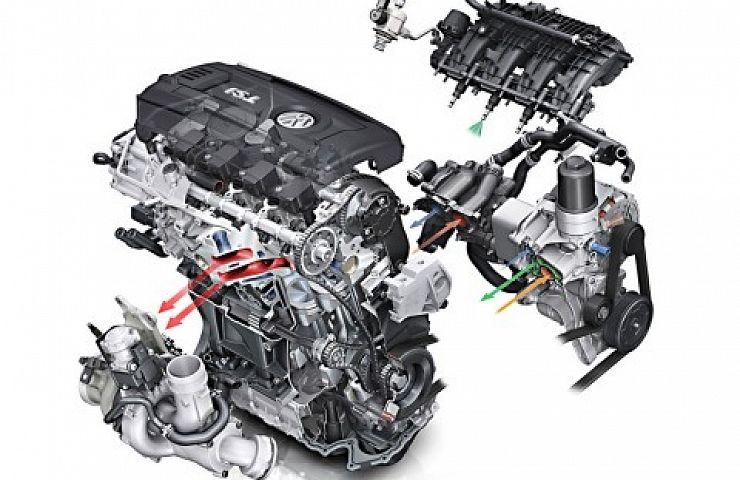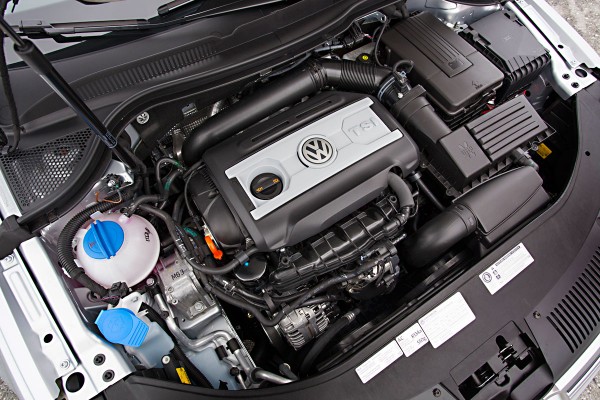The third generation Volkswagen EA888 engine delivers improved efficiency, performance, and drivability.
Likes:
- Improved fuel economy
- More torque available at lower revs equates to better off-the-line acceleration
- Significant engineering achievement decreasing weight and reducing emissions
- Minimal turbo-lag
Dislikes:
- Mild horsepower rating equates to mid-speed acceleration (40 – 60 mph) that is weak
- Not a good match with heavier cars such as the VW CC
- Still a little raspy sounding before the engine reaches full operating temperature
Challenged with stricter emissions regulations and higher CAFE fuel economy standards, Volkswagen engineers have been working hard to update their small displacement engines knowing the tried-and-true gasoline engine still has some potential left in it.

The EA888 Engine Enter a New Era
Recently Volkswagen has introduced the Group’s third-generation EA888 1.8-liter TSI four-cylinder engine in the 2014 Jetta and Passat, followed by the 2014 Beetle. The 1.8-liter unit produces 170 hp and 184 lb-ft of torque as early as 1,500 rpm. The 1.8L TSI engine is widely believed to be the ideal solution for the U.S. market’s aging 2.5-liter four-cylinder units. Remarkably, the horsepower is the same as the outgoing 5-cylinder 2.5-liter engine, but it delivers 7 lb-ft more torque at 2,750 fewer revs and better fuel economy. The 2.0-liter turbocharged version of this engine already made its debut in the 2013 Beetle and Jetta GLI, boasting a 10 horsepower improvement for an output of 210 hp.
Mated to an automatic or a manual transmission, the new EA888 engine offers up to a 17% decrease in fuel consumption. The Jetta equipped with the 1.8T and a six-speed automatic transmission now gets 36 mpg on the highway. That’s up from 31 mpg for the 2.5-liter engine. At the same time, the city mileage improves from 24 to 25 mpg. The overall EPA estimated combined fuel economy is now 29 mpg. That compares with 26 on the outgoing 5-cylinder engine.
New Tech Brings Torque
As well as offering better fuel economy, the new engine’s additional low-speed torque has enhanced the performance. The manual transmission Jetta 1.8T now goes from 0 to 60 mph in a manufacturer estimated 7.3 seconds. This is an improvement of 0.7 seconds over the 2.5-liter model. Chalk one up for the engineers.
Designed to be lighter and more efficient, the new EA888 Gen 3 turbocharged and direct-injection four-cylinder powerplant has a number of significant upgrades. Most notably, a innovative cylinder-head-integrated exhaust manifold with exhaust gas cooling. This is the first implementation of such a system in a turbocharged direct-injection four-cylinder gasoline engine.
The new EA888’s engine design incorporates an integrated cylinder head and water-cooled exhaust manifold. This reduces heat under full load. The new design also eliminates the need to enrich the air/fuel mixture under full load. This result is a reduction in fuel consumption of approximately 20 percent at highway speeds.
Several more innovations contributed to improved performance and fuel economy with the third gen EA888 engine. These measures include reducing engine weight and lowering the amount of internal friction. Most importantly, the turbocharger is redesigned to withstand higher pressures and exhaust temperatures. A new electric wastegate adjusts the on boost pressure, when power is not needed, to help reduced fuel consumption.
EA888 Gen 3 Engine Driving Impressions
We test drove the 2014 Passat and 2014 Jetta outfitted with the 1.8L turbocharged engine. The torque curve is strong and flat from 1,800 to 4,750 rpm. According to VW, peak power should be available as soon as 1,500 rpm. That said, we really began to detect the Jetta and Passat pull stronger starting closer to 1,800 rpm.
Volkswagen TSI engines are widespread across Volkswagen passenger cars, Audi, Skoda and a few other applications. The benefits are obvious: high specific torque available at much lower revs and maintained across a broad rpm range. After sampling the new generation EA888 engine in the Passat, Jetta, CC, and Beetle, we could easily see the cars were much more lively at lower revs. This makes them more economical and cleaner.








